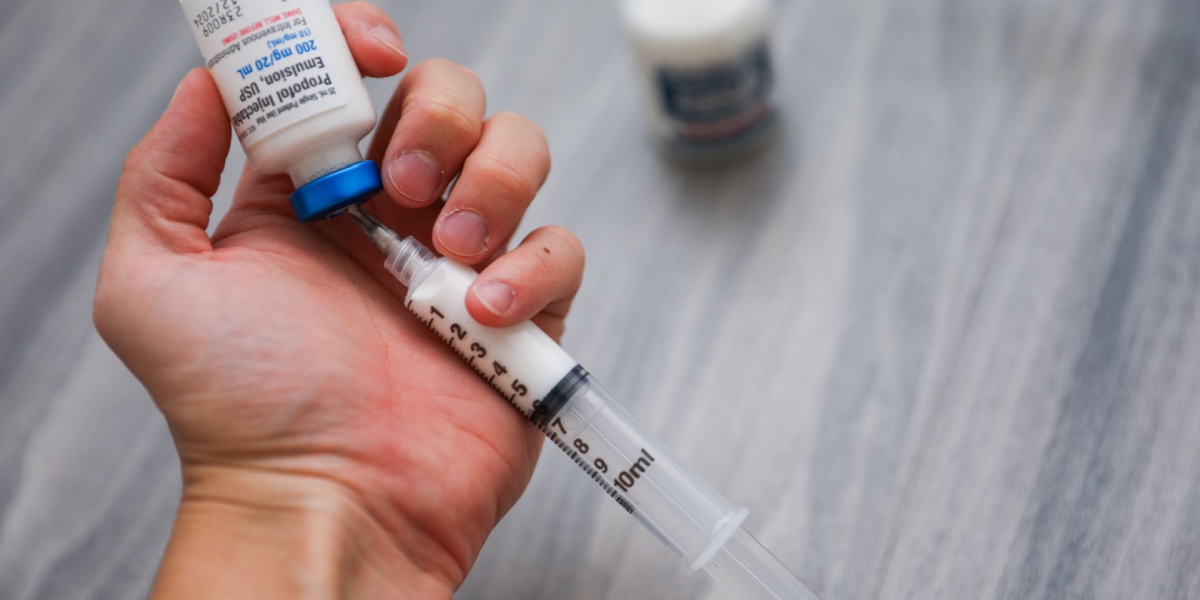Propofol is the fast-acting “milk of amnesia” anesthesiologists use for quick-onset sedation. It calms the brain by boosting the effect of the primary inhibitory messenger, GABA, and it reduces pain signals in the spinal cord through glycine receptors. These actions produce rapid sedation, amnesia, and anxiolysis, with minimal lingering “hangover” once the drug redistributes. [1]
However, propofol also has psychoactive effects. Even subtherapeutic anesthesia doses can cause euphoria, dizziness, and altered perception; at lower doses, individuals report feeling drunk, dizzy, elated, and high with loss of mental and physical control. [1]

What is propofol?
Propofol is an ultra-short-acting intravenous anesthetic agent used to induce and maintain general anesthesia, procedural sedation, and intensive-care ventilation. Nicknamed the “milk of amnesia” for its white, lipid emulsion, it sedates patients in less than 30 seconds. [2]
It wears off within minutes because the drug redistributes rapidly into muscle and fat and then clears through hepatic conjugation and renal excretion. Clinicians prize this fast-on/fast-off profile for smooth recovery, but the identical pharmacokinetics make propofol dangerous to use outside a monitored setting. [2]
Primary medical effects
- Sedation and hypnosis: Propofol potentiates GABA-A receptors in the brain’s cortical and thalamic regions.[3]
- Muscle relaxation and anti-seizure action: Propofol modestly activates glycine receptors in the spinal cord.[3]
- Side effect triad: A unique side effect triad is common with propofol, including burning pain on injection, dose-dependent hypotension with myocardial depression, and respiratory suppression, all of which can be lethal quickly if no airway support is ready.[3]
Propofol's reinforcing effects and addictive potential
Clinically, patients have described well-being, euphoria, and even sexual disinhibition after propofol sedation. These pleasurable effects are linked to the brain’s reward circuitry; like many drugs of abuse, propofol can alter dopamine levels, thus promoting reward disinhibition. [4]
Even tiny doses of propofol can trigger a surge of dopamine in the brain’s reward center, which is called the nucleus accumbens. This is the same brain region targeted by addictive drugs, like opioids and cocaine, which helps explain why propofol use can feel so reinforcing, even though it’s a medical anesthetic. [1]
Propofol’s combination of rapid reward (euphoria) and short duration makes it unusually habit-forming for this drug type. [4] Physical side effects of propofol include pain upon injection (sometimes countered by adding lidocaine), hypotension, myocardial suppression, and respiratory depression, which also contribute to potentially fatal overdoses.
Prevalence of misuse
Propofol misuse is rare in the general public but more common among medical personnel with easy access, particularly anesthesia providers. Surveys show virtually no prevalence among laypeople. [5]
Rates of misuse in medical settings
In one review, only a handful of non-healthcare cases were reported worldwide, while multiple studies found measurable misuse in healthcare settings. For example:
- U.S. anesthesia providers: One American survey found about 10 cases of propofol abuse per 10,000 providers over 10 years (roughly 0.1%). [1] In another convenience sample of recovering anesthesiologists and CRNAs, approximately 3% admitted to propofol misuse. [4]
- Anesthesia departments: A U.S. survey of 126 academic anesthesiology programs (1995–2005) found that 18% of departments reported at least one incident of propofol diversion or abuse. [5]
- Australia/New Zealand: In surveys of substance-abusing anesthetists, propofol was the most common drug abused, implicated in about 41% of abuse cases. [1]
- South Korea: Forensic data (2000–2011) identified 36 propofol-related deaths; 20 were attributed to abuse, and over 70% of victims were healthcare workers (nurses or doctors). [4] A recent study of criminal cases (2013–2020) found 20 convictions for propofol abuse among Korean medical staff (mostly nursing aides); the vast majority (75%) self-administered repeatedly, and most of them received jail sentences (median ~9 months). [6]
Healthcare professionals and addiction risk
Most published case reports of propofol addiction involve health professionals, particularly anesthesiologists and nurse anesthetists. A literature review found 45 documented cases (from 1992 to 2009); 89% involved medical personnel, and 40% were fatal--fifteen deaths among healthcare providers. [4]
Escalation and mortality
Propofol addiction carries an exceptionally high mortality rate. Many reports describe clinicians escalating use from stress relief to compulsive, high-frequency dosing. One anesthesiologist injected propofol 10–15 times a day at the height of his addiction. [4]
Another emergency doctor became physically dependent on propofol and required ICU-level sedation to stabilize. He later died after leaving treatment. [6] Case narratives often note insomnia, anxiety, or stress as initial triggers for propofol use, followed by craving-driven compulsive use. [1][4]
Notable non-clinical cases
Outside the healthcare setting, high-profile incidents illustrate the dangers.
- The 2009 death of singer Michael Jackson (due to inappropriate in-home propofol sedation) brought widespread attention to propofol’s risks. [1]
- Less commonly, propofol has appeared in criminal cases; for example, one recent U.S. lawsuit involved a dental clinic defendant accused of causing a patient’s death by improperly administering propofol.
Overall, these cases underscore that propofol misuse can be lethal, often more so than other anesthetic addictions.
Legal and regulatory status of propofol
Because of its abuse potential, propofol’s legal status is debated. In the United States, propofol itself is not a federally scheduled controlled substance as of 2025. The DEA did propose placing propofol in Schedule IV (similar to fospropofol, which is Schedule IV), and major societies (ASA, AANA) have supported stricter controls. [8]
Propofol is governed by hospital policy (rather than law) for now. Many hospitals require strict inventory, secured storage, and administration only by credentialed anesthesia professionals. [1][6]
Ethical concerns and legal consequences of misuse
Propofol must be handled with extreme caution. Professional and ethical guidelines stress that only qualified clinicians should administer it in a monitored medical setting. [8] Sedating patients or colleagues for non-therapeutic reasons is a grave violation of medical ethics.
Misuse of propofol has led to criminal and malpractice cases, including the high-profile conviction of Dr. Conrad Murray for involuntary manslaughter in the death of Michael Jackson.
In general, any diversion of propofol (such as by theft from hospitals or unauthorized prescriptions) can lead to criminal charges, given its life-threatening risks. Institutions now often audit propofol use and impose drug testing on impaired providers.
Treatment and rehabilitation
No standardized detox protocol exists for propofol addiction, but management parallels that for other sedative-hypnotic dependencies.
Key principles include medical stabilization and supportive care. Withdrawal from propofol can cause agitation, tachycardia, hypertension, and insomnia. If patients have been in ICU-level sedation, they may need monitored tapering in an intensive setting. [9]
Case reports suggest using substitute agents for medication-assisted treatment.
- For example, one ICU patient on prolonged propofol was successfully weaned by introducing intravenous phenobarbital, which blunted withdrawal symptoms and allowed propofol to be rapidly tapered. [9]
- In another case, oral gabapentin (a GABAergic anticonvulsant) helped relieve rebound anxiety in a recovering user. [5]
- More broadly, benzodiazepines or barbiturates might be used short-term to ease the hyperadrenergic state.
Once acute withdrawal is managed, ongoing care focuses on behavioral therapies. Cognitive-behavioral therapy, relapse-prevention counseling, and support groups (similar to Alcoholics Anonymous/Narcotics Anonymous) are appropriate.
Many treatment programs for anesthesiologists with substance use disorders include psychotherapy and peer support. In practice, clinicians often enter specialized rehab (sometimes through medical health programs for physicians/nurses) that monitor them closely.
Overall, long-term recovery involves medical treatment and addressing underlying issues (e.g., stress, depression) that contributed to misuse.

-person-thumbnail.jpg?v=1758880627)
-blog-detail.jpg?v=1722513328)

